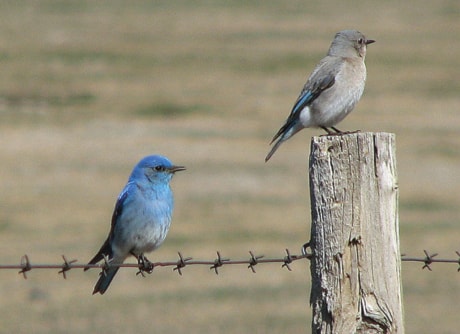It’s shaping up to be another bad year for mountain bluebirds.
Biologist and Ellis Bird Farm site services manager Myrna Pearman says she’s concerned that after late winter weather, “it looks like their numbers are still going to be record low.”
“This year we’ve had periods of cold weather, and last week’s storm was really hard on the birds. We have some nesting, but most of them have wet nests, and some of them have abandoned and will probably start nesting again,” said Pearman of those bluebirds that have already returned.
“It’s going to mean a late start.”
She doesn’t expect a population decimation akin to the 50-per-cent die-off after a late April blizzard in 2008, however. That year, there were only 28 nesting pairs at Ellis Bird Farm, compared to the years of 120 pairs in the early 1990s.
“The night-time temperatures with wind chill were below (-20C), there was snow, and it was cold for eight days,” recalled Pearman. “And the birds just cannot withstand that. They’re early migrants, they overwinter in the southern States and northern Mexico. They can take two or three days of bad weather, but they can’t survive eight days.”
She said there was a slight population rebound in 2009, but a further recovery could be in danger.
Another native cavity nester, tree swallows, also use the bird boxes at Ellis Bird Farm. Usually the bluebirds get back from warmer climes first, set up their territories and defend their houses. But this year, the tree swallows arrived early and are defending their nest sites, said Pearman.
“There’s that added competition. And certainly we welcome the tree swallows, but it’s just one more added pressure for the bluebirds,” she said.
On the upside, Pearman said, is the fact that their purple martins have already started arriving back from their wintering sites in Brazil. The first ones arrived April 30, and another wave came in over the last few days, totalling at least 20 pairs.
“Last year, we had over 50 pairs. So we’re anticipating a better number than last year.”
Other happy changes afoot at the site southeast of Lacombe are upgrades to the tea house kitchen and to a pier area where people can relax and enjoy the wetlands, Pearman said. The former was made possible by a grant from the Community Facility Enhancement Program and the latter from a grant from the Red Deer and District Community Foundation, not to mention annual funding from MEGlobal and individual donations, she said.
One hefty feather in the non-profit organization’s hat is the upcoming addition of the conservation area to the Robert Bateman Get to Know program. A “virtual hike” of the Ellis Bird Farm will be available within the next week at hikes.gettoknow.ca, and student groups will follow up their online exploring with an in-person program that includes a scavenger hunt and puzzles. That launches May 26.
Ellis Bird Farm opens for the season on May 24. For more information, visit www.ellisbirdfarm.ab.ca.
mgauk@www.reddeeradvocate.com
